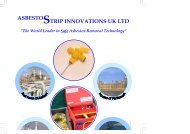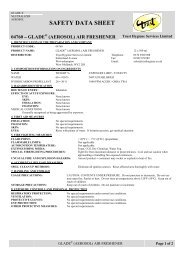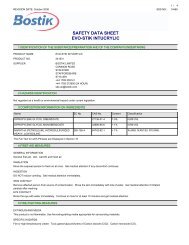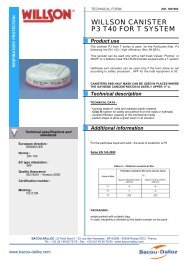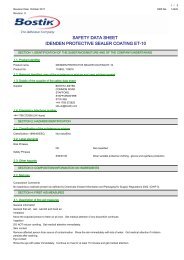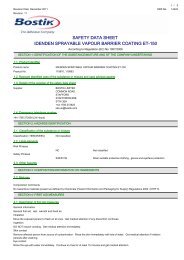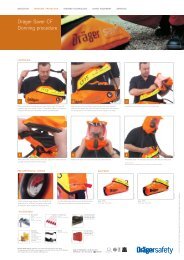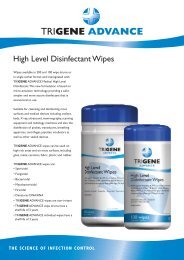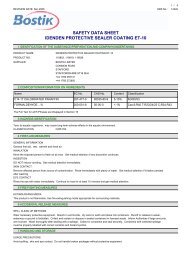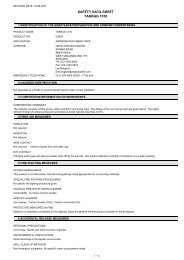Read Safety Data Sheet (PDF) - Dolphin Sealants
Read Safety Data Sheet (PDF) - Dolphin Sealants
Read Safety Data Sheet (PDF) - Dolphin Sealants
You also want an ePaper? Increase the reach of your titles
YUMPU automatically turns print PDFs into web optimized ePapers that Google loves.
SOUDAFOAM 1K B34. First aid measures4.1 Eye contact:- Rinse immediately with plenty of water- Seek medical advice4.2 Skin contact:- Wash immediately with lots of water- If irritation persists: seek medical advice4.3 After inhalation:- Remove the victim into fresh air- Seek medical advice4.4 After ingestion:- Never give water to an unconscious person- Seek medical advice5. Fire-fighting measures5.1 Suitable extinguishing media:- Quantities of water- Polyvalent foam- BC powder- Carbon dioxide5.2 Unsuitable extinguishing media:- None5.3 Special exposure hazards:- On heating: release of toxic/combustible gases/vapours: phosphorus oxides,nitrous vapours, hydrogen chloride, carbon monoxide and carbon dioxide- Gas/vapour spreads at floor level: ignition hazard- Vapour-air mixture is flammable/explosive within the explosion limits- Aerosol may explode under the effect of heat5.4 Instructions:- Dilute toxic gases with water spray- Do not move the load if exposed to heat5.5 Special protective equipment for firefighters:- Heat/fire exposure: compressed air/oxygen apparatus6. Accidental release measures6.1 Personal protection/precautions:See heading 8.1/8.3/10.36.2 Environmental precautions:- Use appropriate containment to avoid environmental contamination6.3 Methods of cleaning up:- Allow product to solidify and remove it by mechanical means- Remove uncured foam with acetonePrinting date : 04-2003 2/11
SOUDAFOAM 1K B37. Handling and storage7.1 Handling:- Observe very strict hygiene - avoid contact- In case of insufficient ventilation: keep naked flames/sparks away- Remove contaminated clothing immediately/reinigen7.2 Storage:- Keep out of direct sunlight- Keep away from: heat sources, ignition sources, acids, basesStorage temperature : < 50 °CQuantity limit : N.D. kgStorage life : 365 daysMaterials for packaging :- suitable :aerosol dispenser7.3 Specific uses:- See information supplied by the manufacturer8. Exposure controls/Personal protection8.1 Exposure limit values:POLYMETHYLENEPOLYPHENYLISOCYANATE:TLV-TWA : - mg/m 3 - ppmTLV-STEL : - mg/m 3 - ppmTLV-Ceiling : - mg/m 3 - ppmMEL-LTEL : 0.02(-NCO) mg/m 3 - ppmMEL-STEL : 0.07(-NCO) mg/m 3 - ppmMAK : - mg/m 3 - ppmTRK : - mg/m 3 - ppmMAC-TGG 8 h : - mg/m 3MAC-TGG 15 min. : - mg/m 3MAC-Ceiling : - mg/m 3VME-8 h : - mg/m 3 - ppmVLE-15 min. : - mg/m 3 - ppmGWBB-8 h : - mg/m 3 - ppmGWK-15 min. : - mg/m 3 - ppmMomentary value : - mg/m 3 - ppmEC : - mg/m 3 - ppmEC-STEL : - mg/m 3 - ppmPrinting date : 04-2003 3/11
ISOBUTANE:SOUDAFOAM 1K B3TLV-TWA : - mg/m 3 - ppmTLV-STEL : - mg/m 3 - ppmTLV-Ceiling : - mg/m 3 - ppmOES-LTEL : - mg/m 3 - ppmOES-STEL : - mg/m 3 - ppmMAK : 2400 mg/m 3 1000 ppmTRK : - mg/m 3 - ppmMAC-TGG 8 h : - mg/m 3MAC-TGG 15 min. : - mg/m 3MAC-Ceiling : - mg/m 3VME-8 h : - mg/m 3 - ppmVLE-15 min. : - mg/m 3 - ppmGWBB-8 h : - mg/m 3 - ppmGWK-15 min. : - mg/m 3 - ppmMomentary value : - mg/m 3 - ppmEC : - mg/m 3 - ppmEC-STEL : - mg/m 3 - ppmDIMETHYL ETHER:PROPANE:TLV-TWA : - mg/m 3 - ppmTLV-STEL : - mg/m 3 - ppmTLV-Ceiling : - mg/m 3 - ppmOES-LTEL : - mg/m 3 400 ppmOES-STEL : - mg/m 3 500 ppmMAK : 1900 mg/m 3 1000 ppmTRK : - mg/m 3 - ppmMAC-TGG 8 h : 950 mg/m 3MAC-TGG 15 min. : 1500 mg/m 3MAC-Ceiling : - mg/m 3VME-8 h : - mg/m 3 - ppmVLE-15 min. : - mg/m 3 - ppmGWBB-8 h : - mg/m 3 - ppmGWK-15 min. : - mg/m 3 - ppmMomentary value : - mg/m 3 - ppmEC : 1920 mg/m 3 1000 ppmEC-STEL : - mg/m 3 - ppmTLV-TWA : - mg/m 3 2500 ppmTLV-STEL : - mg/m 3 - ppmTLV-Ceiling : - mg/m 3 - ppmOES-LTEL : - mg/m 3 - ppmOES-STEL : - mg/m 3 - ppmMAK : 1800 mg/m 3 1000 ppmTRK : - mg/m 3 - ppmMAC-TGG 8 h : - mg/m 3MAC-TGG 15 min. : - mg/m 3MAC-Ceiling : - mg/m 3VME-8 h : - mg/m 3 - ppmVLE-15 min. : - mg/m 3 - ppmGWBB-8 h : - mg/m 3 - ppmGWK-15 min. : - mg/m 3 - ppmMomentary value : - mg/m 3 - ppmEC : - mg/m 3 - ppmEC-STEL : - mg/m 3 - ppmPrinting date : 04-2003 4/11
SOUDAFOAM 1K B38.2 Exposure controls:8.2.1 Occupational exposure controls:- Use only in well ventilated area8.2.2 Environmental exposure controls: see heading 138.3 Personal protection:8.3.1 respiratory protection:- In case of insufficient ventilation: gas mask with filter type A8.3.2 hand protection:- Gloves8.3.3 eye protection:- Protective goggles8.3.4 skin protection:- Protective clothing9. Physical and chemical properties9.1 General information:Appearance (at 20°C)OdourColour: Aerosol: Characteristic: Variable in colour9.2 Important health, safety and environmental information:pH value: N.D.Boiling point/boiling range : N.D. °CFlashpoint: Contains extremely flammablecomponentsExplosion limits : N.D. vol%Vapour pressure (at 20°C) : N.D. hPaVapour pressure (at 50°C) : N.D. hPaRelative density (at 20°C) : N.D.Water solubility: InsolubleSoluble in: N.D.Relative vapour density : N.D.Viscosity : N.D. Pa.sPartition coefficient n-octanol/water : N.D.Evaporation rateratio to butyl acetate : N.D.ratio to ether: N.D.9.3 Other information:Melting point/melting range : N.D. °CAuto-ignition point : N.D. °CSaturation concentration : N.D. g/m 3Printing date : 04-2003 5/11
SOUDAFOAM 1K B310. Stability and reactivity10.1 Conditions to avoid/reactivity:- Unstable on exposure to heat10.2 Materials to avoid:- Heat sources, ignition sources, acids, bases10.3 Hazardous decomposition products:- May polymerize on exposure to temperature rise- On heating: release of toxic/combustible gases/vapours: hydrogen cyanide- On heating: release of toxic/combustible gases/vapours: phosphorus oxides,nitrous vapours, hydrogen chloride, carbon monoxide and carbon dioxide- May polymerize with many compounds e.g.: (strong) bases and amines- Reacts violently with (some) acids/bases11. Toxicological information11.1 Acute toxicity:POLYMETHYLENEPOLYPHENYLISOCYANATE:LD50 oral rat : > 10000 mg/kgLD50 dermal rabbit : N.D. mg/kgLD50 dermal rabbit : > 5000 mg/kgLC50 inhalation rat : N.D. mg/l/4 hLC50 inhalation rat : N.D. ppm/4 hTRIS(2-CHLORO-1-METHYLETHYL)PHOSPHATE:LD50 oral rat : 3600 mg/kgLD50 dermal rabbit : > 2000 mg/kgLD50 dermal rabbit : > 2000 mg/kgLC50 inhalation rat : > 5 mg/l/4 hLC50 inhalation rat : N.D. ppm/4 halpha,alpha',alpha''-1,2,3-PROPANETRIYL-tris(omega-HYDROXY-) POLY[OXY(METHYL-1,2-ETHANEDIYL)]:LD50 oral rat : 1500/2000 mg/kgLD50 dermal rabbit : N.D. mg/kgLD50 dermal rabbit : > 2000 mg/kgLC50 inhalation rat : N.D. mg/l/4 hLC50 inhalation rat : N.D. ppm/4 hISOBUTANE:PROPANE:LD50 oral rat : N.D. mg/kgLD50 dermal rabbit : N.D. mg/kgLD50 dermal rabbit : N.D. mg/kgLC50 inhalation rat : 658 mg/l/4 hLC50 inhalation rat : N.D. ppm/4 hLD50 oral rat : N.D. mg/kgLD50 dermal rabbit : N.D. mg/kgLD50 dermal rabbit : N.D. mg/kgLC50 inhalation rat : 513 mg/l/4 hLC50 inhalation rat : 280000 ppm/4 hPrinting date : 04-2003 6/11
11.2 Chronic toxicity:POLYMETHYLENEPOLYPHENYLISOCYANATE:EC carc. cat.EC muta. cat.EC repr. cat.SOUDAFOAM 1K B3: not listed: not listed: not listedCarcinogenicity (TLV) : not listedCarcinogenicity (MAC) : not listedCarcinogenicity (VME) : not listedCarcinogenicity (GWBB) : not listedCarcinogenicity (MAK) : 3BMutagenicity (MAK) : not listedTeratogenicity (MAK) : -IARC classification : 3DIMETHYL ETHER:EC carc. cat.EC muta. cat.EC repr. cat.: not listed: not listed: not listedCarcinogenicity (TLV) : not listedCarcinogenicity (MAC) : not listedCarcinogenicity (VME) : not listedCarcinogenicity (GWBB) : not listedCarcinogenicity (MAK) : not listedMutagenicity (MAK) : not listedTeratogenicity (MAK) : DIARC classification: not listed11.3 Routes of exposure: inhalation, eyes and skin11.4 Acute effects/symptoms (upon overexposure) :AFTER INHALATION:- Dry/sore throat- Coughing- Irritation of the respiratory tract- Irritation of the nasal mucous membranes- Runny noseFOLLOWING SYMPTOMS MAY APPEAR LATER:- Inflammation of the respiratory tract- Risk of lung oedema- Respiratory difficultiesAFTER SKIN CONTACT:- Tingling/irritation of the skinAFTER EYE CONTACT:- Irritation of the eye tissue- Lacrimation11.5 Chronic effects:- May cause sensitization by skin contact- May cause sensitization by inhalation- Contains substance with uncertain carcinogenic properties(polymethylenepolyphenylisocyanate)ON CONTINUOUS EXPOSURE/CONTACT:- Body temperature rise- Tremor- Feeling of weakness- Headache- Skin rash/inflammation- May stain the skin- Dry skin- Risk of pneumoniaPrinting date : 04-2003 7/11
SOUDAFOAM 1K B312. Ecological information12.1 Ecotoxicity:TRIS(2-CHLORO-1-METHYLETYL)PHOSPHATE:- LC50 (96 h) : 56.2 mg/l (BRACHYDANIO RERIO)- EC50 (48 h) : 65/335 mg/l (DAPHNIA MAGNA)- EC50 (48 h) : 57/97 mg/l (SELENASTRUM CAPRICORNUTUM)12.2 Mobility:- Volatile organic compounds (VOC): 18 %- For other physicochemical properties see section 912.3 Persistence and degradability:- biodegradation BOD 5 : N.D. % ThOD- water : No data available- soil : T ½: N.D. days12.4 Bioaccumulative potential:- log P ow : N.D.- BCF : N.D.12.5 Other adverse effects:- WGK : 1 (classification based on the components in compliancewith Verwaltungsvorschrift wassergefährdender Stoffe(VwVwS) of 17 May 1999)- Effect on the ozone layer : Not dangerous for the ozone layer(1999/45/EC)- Greenhouse effect : No data available- Effect on waste water purification : No data available13. Disposal considerations13.1 Provisions relating to waste:- Waste material code (91/689/EEC, Council Decision 2001/118/EC, O.J. L47 of16/2/2001): 08 05 01 (waste isocyanates)- Waste material code (Flanders): 015; 651- Hazardous waste (91/689/EEC)13.2 Disposal methods:- Specific treatment13.3 Packaging:- Waste material code packaging (91/689/EEC, Council Decision 2001/118/EC,O.J. L47 of 16/2/2001): 15 01 10 (packaging containing residues of orcontaminated by dangerous substances)Printing date : 04-2003 8/11
SOUDAFOAM 1K B314. Transport information14.1 Classification of the substance in compliance with UN RecommendationsUN-number : 1950CLASS : 2.2SUB RISKS : -PACKING : -PROPER SHIPPING NAME :UN 1950, Aerosols14.2 ADR (transport by road)CLASS : 2CLASSIFICATION CODE: 5 ADANGER LABEL TANKS : -DANGER LABEL PACKAGES : 2.214.3 RID (transport by rail)CLASS : 2CLASSIFICATION CODE: 5 ADANGER LABEL TANKS : -DANGER LABEL PACKAGES : 2.214.4 ADNR (transport by inland waterways)CLASS : 2CLASSIFICATION CODE: 5 ADANGER LABEL TANKS : -DANGER LABEL PACKAGES : 2.214.5 IMDG (maritime transport)CLASS : 2.2SUB RISKS : -PACKING : -MFAG : -EMS : 2-13MARINE POLLUTANT : -14.6 ICAO (air transport)CLASS : 2.1SUB RISKS : -PACKING : -PACKING INSTRUCTIONS PASSENGER AIRCRAFT :PACKING INSTRUCTIONS CARGO AIRCRAFT :14.7 Special precautions in connection withtransport14.8 Limited quantities (LQ) :: noneWhen substances and their packaging meet the conditions established byADR/RID/ADNR in chapter 3.4, only the following prescriptions shall becomplied with:each package shall display a diamond-shaped figure with the followinginscription:- ‘UN 1950'or, in the case of different goods with different identification numberswithin a single package:- the letters 'LQ'Printing date : 04-2003 9/11
SOUDAFOAM 1K B315. Regulatory informationLabelling in accordance with EC directives 67/548/EEC and 1999/45/EC (**: seeheading 16)Extremely flammableHarmfulContains: polymethylenepolyphenylisocyanateR20 : Harmful by inhalationR36/37/38 : Irritating to eyes, respiratory system and skinR42/43 : May cause sensitization by inhalation and skin contactS23 : Do not breathe sprayS36/37/39 : Wear suitable protective clothing gloves, and eye/faceprotectionS38 : In case of insufficient ventilation, wear respiratory equipmentS45 : In case of accident or if you feel unwell, seek medical advice(show the label where possible)S51 : Use only in well ventilated areaKeep away from sources of ignition - No smoking.Keep out of reach of children.Pressurized container. Protect from sunlight and do not exposeto temperatures exceeding 50°C.Do not pierce or burn after use.Do not spray on a naked flame or any incandescent materialContains isocyanates. See information supplied by themanufacturer.Printing date : 04-2003 10/11
SOUDAFOAM 1K B316. Other informationThe information provided on this MSDS is correct to the best of our knowledge, information and beliefat the date of its publication. The information given is designed only as a guidance for safehandling, use, processing, storage, transportation, disposal and release and is not to be consideredas a warranty or quality specification. The information relates only to the specific materialdesignated and may not be valid for such material used in combination with any other material or inany process, unless specified in the text.N.A. = NOT APPLICABLEN.D. = NOT DETERMINED* = INTERNAL CLASSIFICATION(**) Labelling:The labelling of the substance described in this MSDS complies with the provisions of Directive1999/45/EC of 31 May 1999, published in the Official Journal of the European Communities L 200 of30/07/1999. This Directive replaces Directive 88/379/EEC of 7 June 1988, published in the OfficialJournal of the European Communities L 187 of 16/07/1988.Member States shall apply the laws, regulations and administrative provisions referred to in article22 of this Directive:(a) to preparations not within the scope of Directive 91/414/EEC or Directive 98/8/EC as from 30 July2002; and(b) to preparations within the scope of Directive 91/414/EEC or Directive 98/8/EC as from 30 July2004.Full text of any R-phrases referred to under heading 2:R12 : Extremely flammableR20 : Harmful by inhalationR22 : Harmful if swallowedR36/37/38 : Irritating to eyes, respiratory system and skinR42/43 : May cause sensitization by inhalation and skin contactR52/53 : Harmful to aquatic organisms, may cause long-term adverse effects in the aquaticenvironmentExposure limits:TLV : Threshold Limit Value - ACGIH US 2000OES : Occupational Exposure Standards - United Kingdom 1999MEL : Maximum Exposure Limits - United Kingdom 1999MAK : Maximale Arbeitsplatzkonzentrationen - Germany 2001TRK : Technische Richtkonzentrationen - Germany 2001MAC : Maximale aanvaarde concentratie - the Netherlands 2002VME : Valeurs limites de Moyenne d’Exposition - France 1999VLE : Valeurs limites d’Exposition à court terme - France 1999GWBB : Grenswaarde beroepsmatige blootstelling - Belgium 1998GWK : Grenswaarde kortstondige blootstelling - Belgium 1998EC : Indicative occupational exposure limit values - directive 2000/39/ECI : Inhalable fraction = T : Total dust = E : Einatembarer AerosolanteilR : Respirable fraction = A : Alveolengängiger Aerosolanteil/Alveolar dustC : Ceiling limita: aerosol r: rook/Rauch (fume)d: damp (vapour) st: stof/Staub (dust)du: dust ve: vezel (fibre)fa: Faser (fibre) va: vapourfi: fibre om: oil mistfu: fume on: olienevel/Ölnebel (oil mist)p: poussière (dust) part: particlesChronic toxicity:K : List of the carcinogenic substances and processes - the Netherlands 2002Printing date : 04-2003 11/11



